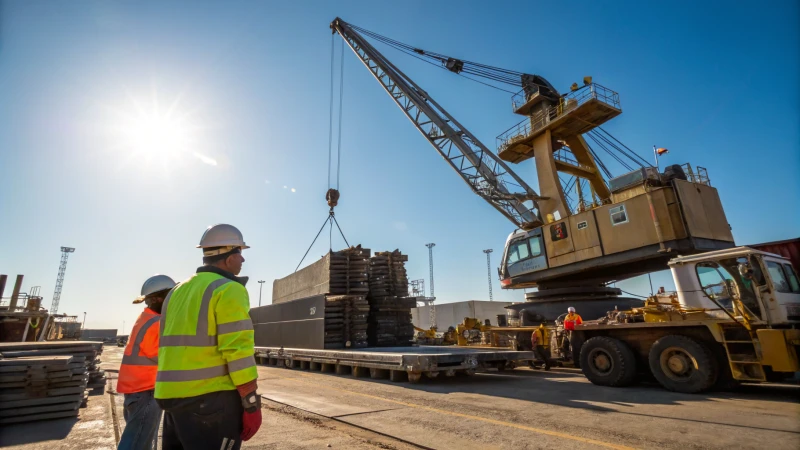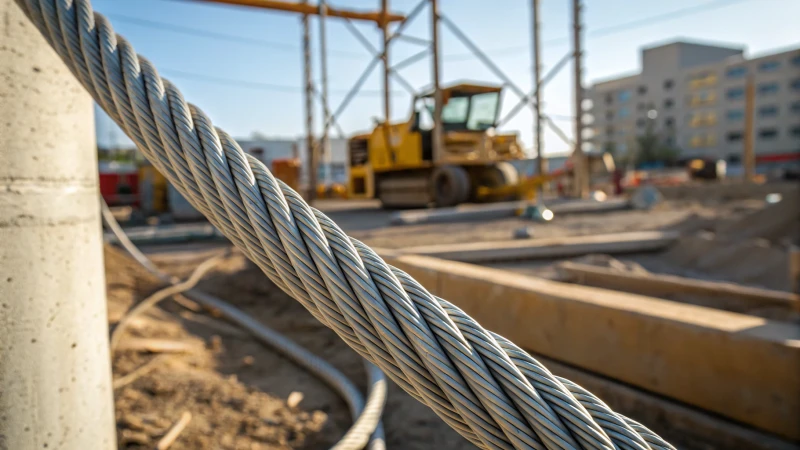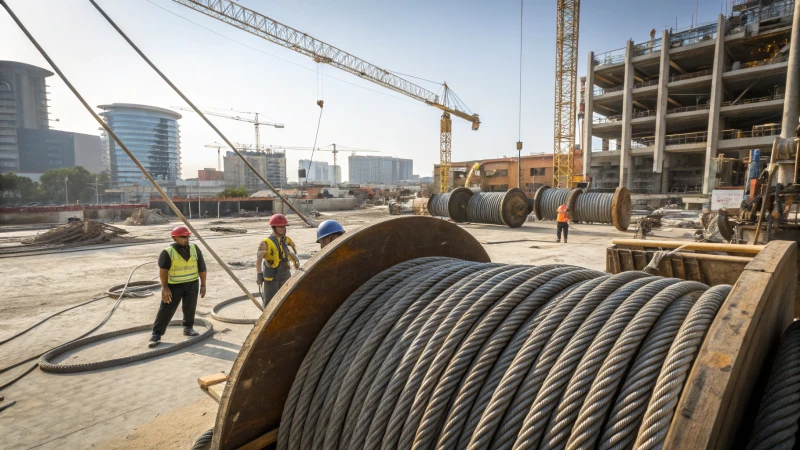
Imagine standing at a construction site, watching a crane effortlessly lift a massive load with ease. What if I told you that the secret lies not in sheer power, but in smart design?
Lightweight wire ropes improve lifting equipment efficiency by minimizing energy use while maintaining strength and durability. Using materials like carbon fiber results in ropes that are lighter yet strong, perfect for modern applications.
I remember the first time I saw a lightweight wire rope in action. It was a game-changer. These ropes not only cut down on energy consumption but also promise greater safety and durability. They’re made with cutting-edge materials like carbon fiber that seem to defy gravity by being both incredibly light and remarkably strong. For those of us working in industries where every second counts—like construction or mining—the implications are huge.
Gone are the days when we had to choose between strength and weight. Now, we can have both, thanks to these innovative designs. They don’t just offer an upgrade in efficiency; they redefine what's possible in lifting operations. The reduced weight means less strain on machinery, potentially lowering maintenance costs and extending equipment life. It’s like trading in an old gas-guzzler for a sleek, efficient hybrid car. We’re not just talking about improvements; we’re talking about a revolution in how we approach lifting tasks.
Lightweight wire ropes improve lifting equipment efficiency.True
Lighter ropes reduce energy consumption and enhance performance in lifting.
Carbon fiber wire ropes are weaker than traditional steel ropes.False
Carbon fiber ropes maintain strength while being lighter than steel.
What Are the Key Materials Used in Lightweight Wire Ropes?
Ever wonder what makes lightweight wire ropes so incredibly strong yet easy to handle? It’s all about the materials! Let me take you on a journey through the innovative fibers and polymers that are transforming industries worldwide.
Lightweight wire ropes rely on materials like carbon fiber and ultra-high molecular weight polyethylene (UHMWPE) for their strength and reduced weight. These components make them perfect for industries demanding both durability and efficiency.

Understanding the Core Materials
Imagine this: I was once overseeing a massive construction project where every ounce of weight mattered. The difference between success and a logistical nightmare often came down to the materials we chose. That's when I discovered the magic of lightweight wire ropes. They’re crafted from materials like:
-
Carbon Fiber: This stuff blew my mind! It offers a strength-to-weight ratio1 that feels almost too good to be true. Picture this—ropes that are up to 30% lighter than traditional steel yet hold their own when it comes to tensile strength.
-
Ultra-High Molecular Weight Polyethylene (UHMWPE): When I first heard about this polymer, I was skeptical. But its resistance to abrasion and impact, combined with being feather-light, quickly won me over. It's no wonder it's favored in maritime and aerospace settings.
-
Aramid Fibers: If you've ever worked in a high-heat environment, you'll know how crucial durability is. Aramid fibers thrive where others falter, shrugging off heat like it's nothing.
Comparing Material Properties
| Material | Key Properties | Applications |
|---|---|---|
| Carbon Fiber | High tensile strength, lightweight | Aerospace, Construction |
| UHMWPE | Abrasion-resistant, low weight | Marine, Sports Equipment |
| Aramid Fiber | Heat-resistant, durable | Automotive, Industrial Machinery |
Advantages Over Traditional Materials
I have seen firsthand how traditional steel ropes, though sturdy, can be cumbersome and prone to corrosion. But when I switched to lightweight ropes made from modern materials2, I noticed several advantages:
-
Corrosion Resistance: These synthetic fibers are tough cookies when it comes to corrosive environments. Unlike steel, they don't succumb easily.
-
Ease of Handling: I can’t stress enough how much easier these ropes are to work with—they’re lightweight, making installation a breeze and cutting down on labor costs.
Applications Across Industries
I’ve worked across various sectors—from construction to marine—and I've watched lightweight wire ropes become indispensable due to their unique properties:
- Construction: In cranes and elevators, these ropes provide incredible load-bearing capacity without the added bulk.
- Mining: They help lift heavy loads while keeping equipment manageable in weight.
- Marine and Fishing: Their resistance to saltwater corrosion is a game-changer for these industries.
With the ongoing push towards efficiency and sustainability, these materials aren't just trends—they're the future of wire rope technology. As industries look for ways to enhance performance while maintaining safety standards through innovations in material science3, these advanced materials are leading the way.
Carbon fiber is 30% lighter than steel.True
Carbon fiber offers superior tensile strength and is up to 30% lighter than steel.
UHMWPE is heavier than traditional steel ropes.False
UHMWPE is lightweight, making it a preferred choice over heavy traditional steel ropes.
How Does Lightweight Design Contribute to Energy Efficiency?
Ever wonder how shedding a few pounds can make such a difference in energy consumption?
Lightweight design boosts energy efficiency by minimizing the mass to be moved, thus reducing fuel or energy use. It's especially effective in vehicles, where materials like carbon fiber cut fuel usage and emissions significantly.

Understanding Lightweight Materials
I remember the first time I encountered lightweight materials in action. It was during a visit to a local automotive plant where I saw carbon fiber composites4 being used to craft car bodies. These materials are not only about shedding weight; they maintain impressive strength despite being lighter. Imagine a car that’s 30% lighter yet just as strong as its steel counterpart. That’s the magic of carbon fiber and aluminum alloys.
| Material | Weight Reduction | Strength Retention |
|---|---|---|
| Carbon Fiber | 30% lighter | Maintains strength |
| Aluminum Alloys | 50% lighter | Retains rigidity |
This reduction in mass means that whether you're driving a car or flying a plane, less energy is required to move it.
Impact on Vehicle Design
Think about this: every pound you shave off a vehicle's weight means less energy needed to move it. In automotive engineering, this translates directly into better fuel efficiency5. I once talked to a friend who drives a modern electric car, and she shared how aluminum and magnesium components not only improved her vehicle's range but also its overall energy efficiency. It’s fascinating how manufacturers have replaced heavy steel parts without compromising safety or performance.
- Example: Modern electric vehicles often incorporate aluminum and magnesium to improve range and energy efficiency.
Application Beyond Automotive
Lightweight design isn’t just for cars and planes; it has a place in construction and manufacturing too. I recall reading about lightweight concrete6 being used in a skyscraper project, making the structure lighter and more energy-efficient to build. Similarly, manufacturing equipment made with lightweight materials uses less energy, aligning perfectly with eco-friendly goals. It’s all part of a global shift toward reducing carbon footprints.
Understanding how lightweight design fuels energy efficiency empowers industries to make informed choices that are both environmentally and economically sound.
Carbon fiber is 30% lighter than traditional materials.True
Carbon fiber offers significant weight reduction while maintaining strength.
Lightweight design only benefits the automotive industry.False
It also benefits aerospace, construction, and manufacturing industries.
What are the safety implications of using lightweight wire ropes?
Imagine lifting a heavy load and feeling the ground tremble beneath your feet. That's the power of wire ropes, especially when they’re lightweight yet strong.
The safety implications of lightweight wire ropes involve potential durability challenges and increased wear in demanding conditions. Addressing these involves regular checks, proper evaluations, and strict adherence to safety protocols.

Understanding Material Properties
I remember the first time I encountered lightweight wire ropes made from carbon fiber and ultra-high molecular weight polyethylene. It was like magic—seeing something so light yet incredibly strong. These materials offer superior strength7 while slashing weight, which is great for reducing the overall load. But, like anything magical, there's a catch. In high-stress environments, these ropes might wear down faster than you'd expect.
| Material | Strength (MPa) | Weight Reduction (%) |
|---|---|---|
| Carbon Fiber | 2500-3500 | 30 |
| Ultra-high Molecular Weight Polyethylene | 2900-4000 | 50 |
Risk of Reduced Durability
Think of it like your favorite pair of running shoes. They're fantastic for a while but start showing signs of wear when you push them too hard. Similarly, lightweight wire ropes can be more susceptible to abrasion compared to their heavier counterparts. This can lead to quicker degradation if not properly maintained. Regular inspections are crucial—just like checking those shoes for worn-out soles—to spot any early signs of wear8 and fix them before they cause bigger problems.
Safety Standards Compliance
I can't stress enough how vital it is to follow industry safety standards with these ropes. It's like having a roadmap that guides you safely through all the twists and turns. Standards from ISO and ASTM provide guidelines for safe usage9 and testing protocols to ensure that you use the ropes safely, minimizing the risk of unexpected failures.
Importance of Regular Maintenance
Maintenance isn’t just a chore; it’s your best friend when working with wire ropes. Picture it as a routine check-up to keep everything running smoothly. Frequent inspections involve checking for fraying, corrosion, or other signs of damage. Maintenance schedules10 should be strictly followed to ensure the integrity of the wire ropes over time.
Environmental Considerations
Environmental conditions are another piece of this complex puzzle. Imagine leaving your bike out in the sun and rain without a cover—it’s going to take a hit. Lightweight ropes, especially those made from carbon fiber, may degrade under UV exposure unless adequate protection11 is applied. So picking the right rope for your environment is as crucial as choosing the right gear for a biking adventure.
Understanding these factors isn't just theoretical; it's practical wisdom that procurement managers, engineers, and safety officers need to make informed choices about wire ropes. It's about weaving safety into every project plan, ensuring that when you're lifting something heavy, it's not just going up—it's going up safely.
Lightweight wire ropes are less durable than steel ropes.True
Lightweight ropes can degrade faster due to abrasion, requiring regular checks.
Carbon fiber ropes are unaffected by UV exposure.False
Carbon fiber can degrade under UV unless protected, affecting performance.
How Do Lightweight Wire Ropes Impact Maintenance and Longevity?
Imagine a world where maintaining heavy machinery becomes as light as a feather. Intrigued? Read on to discover how lightweight wire ropes are revolutionizing maintenance and boosting longevity across various industries.
Lightweight wire ropes crafted from materials like carbon fiber significantly reduce maintenance needs due to their superior durability and resistance to environmental damage. Compared to traditional steel ropes, they offer extended lifespans, enhancing operational efficiency and cutting costs.

Materials Matter: Carbon Fiber and Beyond
When I first heard about lightweight wire ropes made from carbon fiber12 and ultra-high molecular weight polyethylene (UHMWPE), it was like a lightbulb moment. I remembered the time when we struggled with heavy steel ropes during a project; the idea of something lighter but equally strong seemed almost magical.
Why Material Selection is Key:
- Carbon Fiber: It’s remarkable how these ropes, about 30% lighter than steel, can alleviate the strain on equipment. Imagine less wear on your machinery—what a relief!
- UHMWPE: This material is like the superhero of abrasion resistance, perfect for those harsh conditions we often face in construction or mining.
| Material | Weight Reduction | Key Benefits |
|---|---|---|
| Carbon Fiber | 30% | High strength, lightweight |
| UHMWPE | Variable | Abrasion resistant, durable |
Maintenance Dynamics: Less is More
Switching to these lightweight options has been a game-changer for me. Remember those endless hours spent on lubrication and corrosion checks? Those days are slowly fading away. The advanced polymers in these ropes mean less frequent maintenance, which is a huge win in my book.
- Reduced Wear and Tear: The reduced friction is like a gentle breeze compared to the usual grind, leading to longer-lasting ropes and less downtime.
- Environmental Resistance: It’s reassuring knowing that these materials withstand saltwater and chemicals, making them ideal for marine applications13.
Economic Impacts: Cost vs. Savings
Initially, I hesitated about the higher upfront cost. But looking back now, the savings in maintenance and the longevity of these ropes truly offset the initial investment. Plus, the boost in operational efficiency—it’s like getting an extra coffee break every day!
- Initial Investment: Yes, the cost is higher at first, but think of it as paying for peace of mind and long-term savings.
- Operational Efficiency: Imagine lighter equipment that conserves energy and speeds up processes—it's not just a dream anymore.
The more I delve into the benefits of lightweight wire ropes, the clearer it becomes that they’re not just an upgrade—they’re a revolution. They transform not only how we maintain our equipment but also how we calculate long-term savings and performance. Whether you’re in construction, mining, or manufacturing, understanding these dynamics is crucial for achieving safety, cost-effectiveness, and enhanced performance in your operations.
Carbon fiber ropes reduce equipment weight by 30%.True
Carbon fiber ropes are known to be about 30% lighter than steel.
Lightweight ropes require more frequent maintenance than steel.False
Lightweight ropes reduce maintenance needs due to their durable materials.
Conclusion
Lightweight wire ropes enhance lifting equipment efficiency by reducing energy consumption while maintaining strength, utilizing advanced materials like carbon fiber and UHMWPE for improved durability and safety.
-
Learn how carbon fiber's high tensile strength contributes to the durability and efficiency of wire ropes. ↩
-
Explore various modern materials utilized in wire rope manufacturing and their benefits over traditional options. ↩
-
Discover recent advancements in material science that improve industrial products like lightweight wire ropes. ↩
-
Discover why carbon fiber composites are preferred for their strength-to-weight ratio, offering substantial weight reduction without sacrificing durability. ↩
-
Learn how vehicle weight reduction can enhance fuel efficiency and reduce emissions, crucial for sustainable transportation. ↩
-
Explore the advantages of lightweight concrete in construction, including reduced load and improved energy efficiency in buildings. ↩
-
Explore the detailed tensile strength properties of carbon fiber wire ropes, essential for evaluating their performance in heavy-duty applications. ↩
-
Find guidance on inspecting wire ropes for signs of wear, an essential practice for maintaining safety and performance. ↩
-
Discover key safety standards like ISO and ASTM relevant to wire ropes, ensuring compliance in critical applications. ↩
-
Understand the best practices for establishing a maintenance schedule for wire ropes, vital for long-term safety and reliability. ↩
-
Learn about UV protection measures for carbon fiber materials, important for preventing degradation in outdoor use. ↩
-
Explore the superior properties of carbon fiber that contribute to its high strength-to-weight ratio, making it ideal for industrial applications. ↩
-
Understand how advanced materials resist corrosion in marine environments, enhancing rope longevity and performance. ↩

